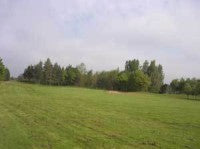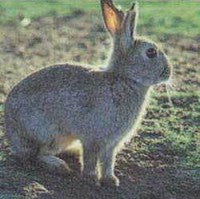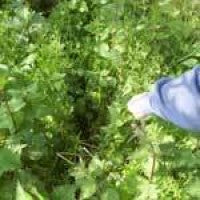The European Rabbit
The European Rabbit
By Neville Wilkes

Today I am walking around The Great Hay golf course in Telford looking for evidence of rabbit activity. Rabbits can cause a serious amount of damage and devastation to playing surfaces, especially on golf courses. Rabbits will venture on to greens and tees and dig holes into the playing surfaces. Rabbits are creatures of habit and will, once established, continue to return and cause damage to the turf.
There are a number of methods for controlling rabbits:
- Fencing
- Shooting
- Trapping using various methods (netting, snaring)
- Ferreting
- Dogs
- Poison
- Repellants
Before any of the above can be used it is important to understand the life cycle and habits of the rabbit.
Most UK golf courses are set in 300-600 acres of land, of which half is usually allocated to woodlands, scrub and naturalised landscape, providing the ideal habitat for many animals, including rabbits, to thrive. Managing and understanding their environment is the key to good rabbit control.

As the old saying goes, they do breed like rabbits. Rabbits are able to have one or two litters per year. On average there are five in a litter, but can be up to nine. Even the offspring born in April can themselves give birth to their own litters later in the same year.
Rabbits generally live in tunnels and burrows, collectively called warrens, that are dug into earths or banks of soil within their territory. These warrens provide shelter and often a place of refuge during the day. These tunnels and chambers also provide a means of escape, having many boltholes that enable the rabbit to exit the burrows quickly.
Some rabbits do not live in burrows and remain outside all the time, often taking shelter (squatting) under dense foliage. This change in behaviour came about during the late sixties early seventies when millions of rabbits contracted myxomatosis, a man-introduced disease that brought devastation to the populations in the UK.
Rabbits have been known to live for nine years, however this is not common. Most wild rabbits die within two years. A buck rabbit (male) will often serve 2-3 females (does) in one season, with the mating season beginning December/January time. The doe builds a nest in a shallow hole, lining it with dry leaves and debris found locally. Baby rabbits (kittens), first born, are blind and furless. The kittens remain in the nest for about a month, after which they venture out to feed and, during this time, they are vulnerable to a number of predators, namely, foxes, weasels, stoats and some birds of prey.
Habitat:
Rabbits will soon colonise an area if the habitat offers them the opportunity to survive. They require sandy, loamy soils enabling them to dig burrows and tunnels easily, groundcover for shelter and an ample supply of grass nearby to graze on. Rabbits rarely drink water. They obtain their water intake from the grass plant. Rabbits, if not controlled, can cause untold damage to playing surfaces and vegetation on golf courses with the four main problems being:
- Extensive grazing of grass; rabbits can eat up to 30% of their own body weight per day, around 500 grams.
- Digging holes, rabbits will dig holes to find succulent young roots to feed on.
- Rabbits will eat the bark of young trees, with ash being a particular favourite, to obtain a nutritional food source, especially in the winter months when food supplies are low and there is very little grass about.
- The urine and droppings of the rabbits will often kill or stain fine grass swards

|

|

|
| Rabbit run | Rabbit damage | Rabbit bolt hole |
Control:
There are a number of methods available and the choice will be dependent on a number of factors:
- Number of rabbits.
- Location.
- Size and accessibility of colony (warrens).
- Environmental factors, proximity to houses, people, water.
- Public sensitivity.
One effective method is to deter rabbits from remaining in the vicinity. This would involve removing their environment by mowing down scrub growth and ploughing up their warren, thus destroying their territory and forcing the rabbits to move away.
Fencing off areas to prevent access can be expensive but usually effective, and can last 10-15 years.
Where it is impractical or uneconomic to protect young trees by fencing, individual tree guards can be used. There are many types including plastic or welded wire-mesh cylinders which are supported on stakes, split plastic tubes or spiral plastic sleeves that fit closely around the trunk of the tree.
Shooting rabbits is another option but public opinion is often against this form of control, together with the strict gun control legislation restricting use in certain situations.
The Protection of Animals Act 1911 requires that all traps set for the purpose of catching rabbits (or hares) should be visited at reasonable intervals and at least once every day between sunrise and sunset. Trapping is a widely practised but requires trained and experienced people to be successful.
Trapping:
Baited cage trapping. A method more appropriate for protecting high value crops and where manpower is available for frequent checking of traps. Any non-target species that are captured can be released unharmed. The technique does not require access to the rabbit burrows. Traps are placed in the runs and baited with oatmeal or similar food. Traps should be checked twice a day, early morning and late afternoon. Any captured rabbits must be humanely despatched.
Spring trapping. Under the Pests Act 1954, only approved spring traps designed to catch and kill rabbits humanely may be used. Those currently approved by the Spring Traps Approval Order 1995 are the Imbra Trap Mark I and Mark II, Juby Trap, Fenn Rabbit Trap Mark I, Fenn Vermin Trap Mark VI (Multi Purpose), Springer Mark VI (Dual Purpose), Victor Conibear 120-2 and the BMI Magnum 116. All spring traps must be set in natural or artificial tunnels which are, in either case, suitable for the purpose.
Netting. Usually done late at night when dark. It involves setting up a net up to 100 metres long at the base of a hedgerow by their feeding areas. It is important to walk against the wind ensuring the rabbits do not get your scent. Two people are required to set the net, rolling it out and pegging it down (net 100x1m). Once set, a noise is made to scare the rabbits into the shelter of the hedgerow, becoming trapped in the net.
Snaring. A skilled operation involving the placement of snares in locations that the rabbit frequently uses. Rabbits usually have regular runs through scrub and undergrowth. It is vital that once the snare has been set, usually in the evening, a visit is made first thing the next day to check. Leaving snares unattended often can mean other animals may be caught or injured by these devices.
Ferreting:
A ferret's natural instinct is to catch and kill, usually by a single bite at the back of the rabbit's neck. Generally three ferrets are used - two gills (females) and one male. Prior to putting the ferrets down the burrows the site has to be secured by covering all the exit routes from the warren with nets. The ferrets will disturb the rabbits forcing them to run into the nets.
Dogs:
Using terrier dogs in the same way as ferrets to chase the rabbits from the warrens. Another method involves using whippet/collie dogs. At night, a light is shone into the eyes of the rabbit. It's reaction is to remain motionless enabling the dog to catch it. This method is called lamping.
Poison:
Gassing can reduce the rabbit population by up to 80%. It is essential that rabbits lying out be driven to ground before warrens are gassed. Particular attention should be paid to the possible presence of badger setts or fox earths. It is illegal to gas badgers or foxes so burrows in or around setts and earths must not be treated. The impact on other wildlife living in burrows, for example adders, may also need to be considered. A fumigant based on sodium cyanide is available. The commercial formulation, Cymag (Sorex Ltd) gives off hydrogen cyanide gas on contact with moist air or soil. The powder can be blown into burrows by power or hand pump, or placed inside the entrance with a spoon. However this product is now being withdrawn from market. under new legislation laws and will only be available until stocks run out.
A number of materials containing metallic phosphides, which generate phosphine gas on contact with moisture, are also available. These are either in tablet or pellet form. Fumigants must be approved under the Control of Pesticides Regulations 1986 and must be used according to label instructions. Gassing should be undertaken by two trained persons and must not be carried out in wet or windy conditions. Fumigants can be lethal to humans and it is essential that users follow the instructions on safety aspects and comply to relevant legislation regarding the Control of Substances Hazardous to Health (COSHH).
Users must carry out an assessment as required by the Control of Substances Hazardous to Health Regulations 1999. Guidance on this aspect is provided in Agriculture Information Sheet No 22 available free from the HSE. The choice of formulation should take account of considerations such as operator safety requirements and site conditions.
Repellents:
There are a number of commercial products on the market, however these can be expensive and generally do not provide long term protection from attack. Make sure you choose a product that is safe to use around children and pets. Pepper and bone meal sprinkled around the rabbits' favourite food can often discourage them.
Only repellents approved under the Control of Pesticides Regulations 1986 may be used.
Legal considerations:
Under the Wild Mammals (Protection) Act 1996, it is an offence to intentionally inflict unnecessary suffering as specified by the Act on any wild mammal. This legislation may need to be considered where the destruction of occupied warrens and burrow systems is being contemplated. An Order has been made under Section One of the Pests Act 1954 by which England and Wales (except for the City of London, the Isles of Scilly and Skokholm Island) have been declared a Rabbit Clearance Area.
In this area, every occupier of land is responsible for destroying wild rabbits on his land. Where it is not reasonably practical to destroy them, occupiers must take steps to prevent damage. The Department has powers to require rabbit control to be carried out; if this is not done, he may arrange for the necessary work to be undertaken at the expense of the occupier, who could also be liable to a fine.
The Ground Game Act 1880 gives every occupier of land a limited right to kill and take rabbits and hares concurrently with the right of any other person entitled to do so on the same land. An occupier may use any legal method to kill rabbits, such as gassing, trapping, ferreting, shooting, snaring, netting, and, with the exception of shooting, he may authorise other persons to assist him. The Ground Game Act exempts an occupier, and persons authorised by him to kill rabbits, from the need to hold a game licence.
Myxomatosis:
Originally, myxomatosis was introduced from Brazil (where it was first discovered in the 1930's) in to Australia in 1950 where it was used to control the massive population of rabbits in that subcontinent. French Physician, Dr A Delille, who wished to control the rabbit population on his country estate near Paris, brought the disease from Australia.
The disease spread rapidly into the wild rabbit population in France and was then brought into Britain in 1953. There is no evidence that the disease was intentionally brought in, but there is no doubt that some farmers moved the disease around using diseased rabbits to control the population locally.
A virus causes the disease. The first signs are puffy swellings around the head and face. 'Sleepy eyes' are a classic sign along with swollen lips, tiny swellings on the inside of the ear and puffy swelling around the anus and genitalia. Within a day or so, these swellings can become so severe as to cause blindness and there may be some distortion around the face, mouth, ears and nose, so feeding and drinking is often difficult.
Wild rabbits suffering from myxomatosis become easy prey to animals such as foxes and other predators. Others may well become injured or killed on roads but the common cause of death is secondary lung infection which occurs around day eight after the initial incubation of the disease.
Myxomatosis killed millions of rabbits during the 1960's and 1970's. As the years went by some rabbits began to build up a resistance to the disease and now we see very fewer cases occurring in the wild today.
The disease is spread by blood sucking insects. A major insect parasite that transmits the disease in this country is the rabbit flea, which is frequently found on wild rabbits. In other countries, including some European countries, it is known that mosquitoes are a major insect vector of myxomatosis. The rabbits would effectively spread the disease to one another by the mere fact that they shared burrows, enabling the flea to be passed from one rabbit to another.
The rabbits got wise to this and, over time, changed the way they behaved with some not spending too much time in burrows and tunnels, and often remaining above ground.
Useful Sites:
www.defra.gov.uk/wildlife-countryside/vertebrates/rabbit.htm
www.defra.gov.uk/wildlife-countryside/vertebrates/approved-traps.htm
